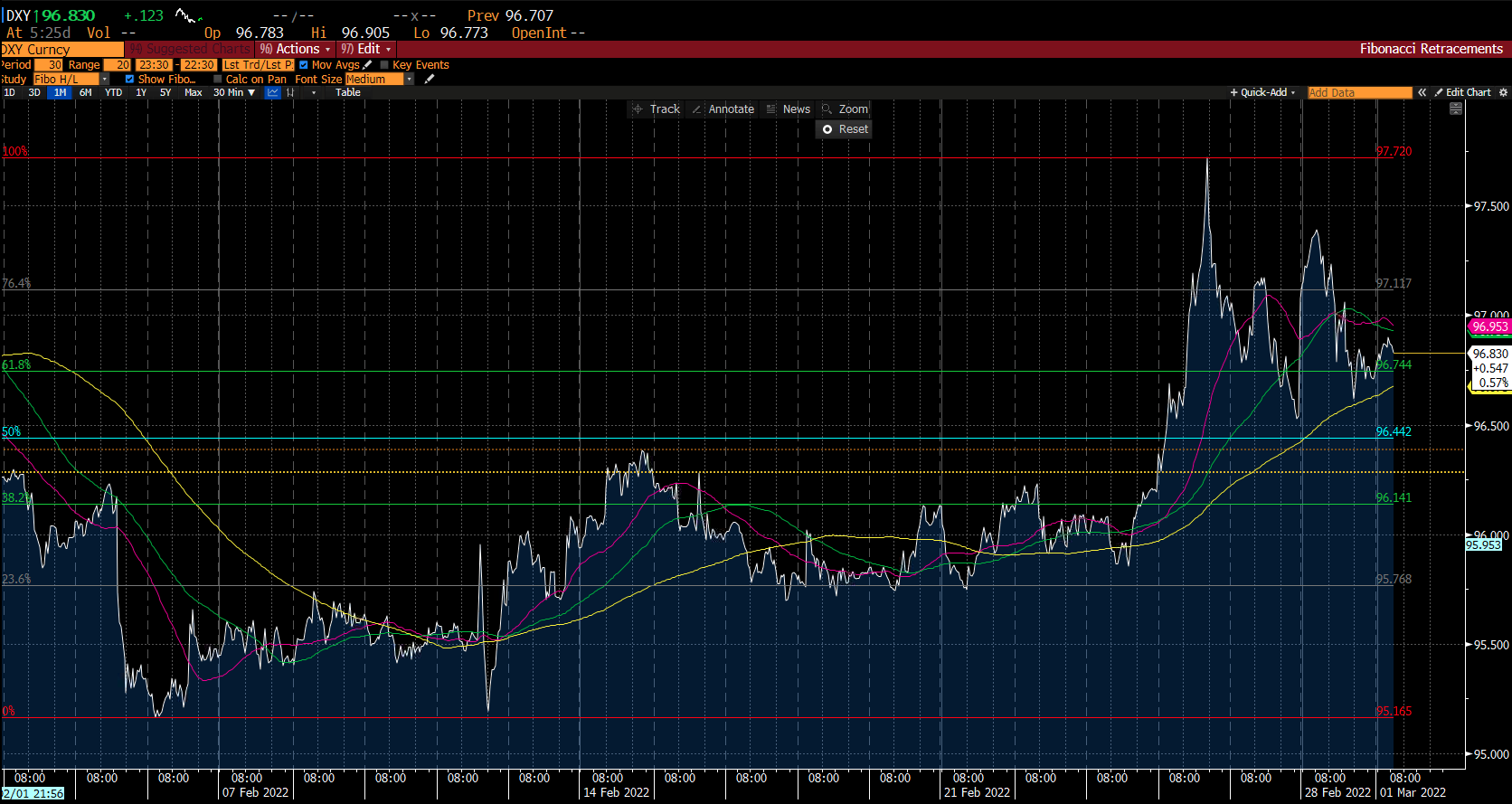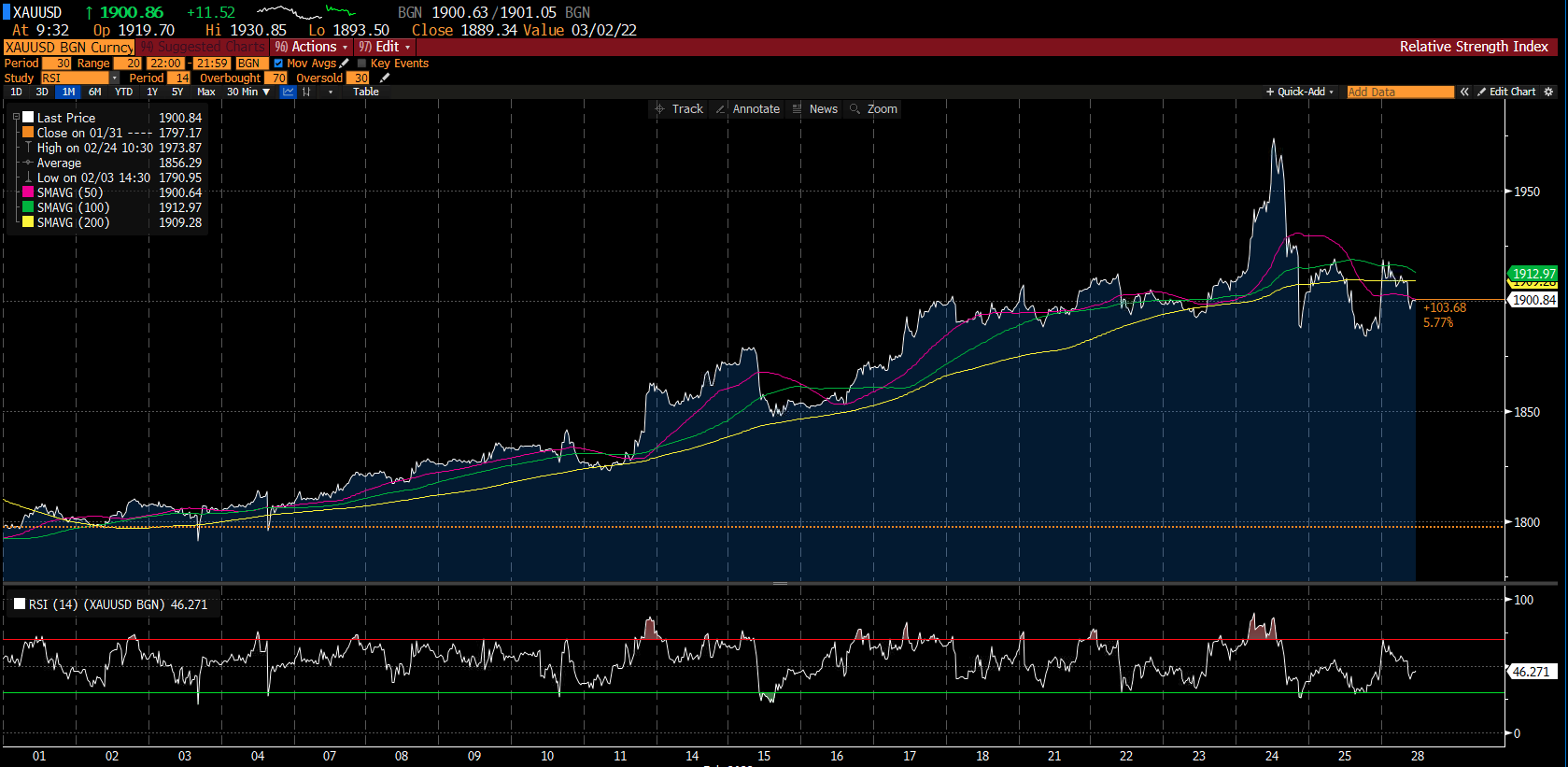Forex
Source: Bloomberg. Click to see full size
The US dollar index (DXY) began last week by capitalising on safe-haven flows amid rising geopolitical tensions. Among the pairs that reacted to this, the EUR/USD hit a fresh 2022 low of $1.11118 just as markets opened. Furthermore, the USD/JPY pair opened at ¥115.14 and hit a high of ¥115.78 shortly after the announcement that Ukraine and Russia would hold their first diplomatic talks since the Kremlin invasion.
On Monday, 21 February 2022, the Russian rouble was reported to have lost more than 40% against the US dollar on the interbank market. In response, the central bank of Russia raised its benchmark interest rate to 20%. The central bank said that the rate hike is intended to offset depreciation risks and inflation risks associated with the rouble.
For the first time, the European Union (EU) decided to provide weapons aid to a nation at war. According to Reuters, the EU will send 450 million euros worth of weaponry to its eastern neighbour. In addition to that, over the weekend, the US and the EU and other Western nations decided to exclude some Russian financial institutions from the global payment system, SWIFT.
Commodities
Source: Bloomberg. Click to see full size
Gold could not build on its previous week’s gains because of the improved market mood at the start of last week. This sentiment was fuelled by renewed hopes of a diplomatic solution to the Russia-Ukraine crisis. As gold was the most vulnerable asset to a shift in risk perception, its price fluctuated wildly throughout the week.
After a rally to its highest level since September 2020 at $1,974, gold fell below $1,900 early in the American session on Friday, 25 February 2022, ending a three-week winning streak. The chart above shows that gold is currently trading at $1,900.84. Gold’s RSI indicator sits at 46.3 and is just above the 50 SMA at $1,900.64 and below the 100 SMA and 200 SMA levels at $1,912.97 and $1,909.28.
In the oil markets, WTI Crude oil hit $100 per barrel for the first time since 2014, as global geopolitical concerns turned into a visible threat with Russian President Vladimir Putin announcing a military operation in Ukraine. However, it could not sustain this high for long and retreated, but did not drop below $90 per barrel.
Additionally, the US Energy Information Administration (EIA) reported a second consecutive increase in domestic crude oil inventories for the week ending on Thursday, 24 February 2022. According to EIA data, US commercial crude stockpiles increased by 4.5 million barrels last week totalling to 416 million barrels, putting them at about 9% below the five-year average.
This week’s economic calendar will include several high-level data releases, but traders are likely to remain focused on geopolitical headlines. Last week’s market action demonstrated that gold is the preferred safe-haven asset, but it is also the first to be sold when sentiment improves. If Russia reaffirms its intention to seek a diplomatic solution and refrains from advancing its troops early this week, gold may face additional selling pressure. On the other hand, a protracted military conflict with Russia’s intent to take over Kyiv and additional sanctions from the West could support the precious metal.
US Indices
|
Name of the index |
Friday’s close |
*Net Change |
*Net Change (%) |
|
Dow Jones Industrial (Wall Street 30) |
34,058.75 |
462.14 |
1.38% |
|
Nasdaq (US Tech 100) |
14,189.16 |
318.63 |
2.30% |
|
S&P 500 (US 500) |
4,384.65 |
79.89 |
1.86% |
Source: Bloomberg
*Net change and net change % are based on the weekly closing price change from Monday to Friday.
Global stock markets were highly volatile last week as traders reacted to Russia’s invasion of Ukraine. Following a midweek sell-off in equities, markets swiftly recovered during the week’s late trading sessions.
On Tuesday, 22 February 2022, risk assets fell as traders assessed the financial market’s reaction to escalating military tensions and increased sanctions against Russia.
The US indices extended losses on Wednesday, 23 February 2022, pushing the Dow Jones and S&P 500 to their lowest levels in 2022. Despite steep declines the previous day, all three indices climbed on Friday, 25 February 2022. Based on Bloomberg data, the Dow Jones Industrial Average closed 1.38% higher at around $33,502. The S&P 500 and the Nasdaq 100 also ended in the green, closing higher at 1.86% and 2.30%, respectively.
As the US released its initial set of sanctions against Russian financial institutions and sovereign debt, hopes of a diplomatic resolution between Russia and Ukraine appeared to dim. However, on Friday, 25 February 2022, market sentiment boosted after the Kremlin reportedly announced that Vladimir Putin was ready to send a delegation for negotiations with Ukraine.
For US traders, geopolitical tensions will further complicate the Federal Reserve’s next economic policy move, which has thus far prioritised reducing inflationary pressures via hawkish monetary policy changes. Increasing prices from the escalating conflict would complicate Fed policy, causing the Fed to have to decide whether to increase rates in the midst of an energy-stressed, slowing economy.
Trade the financial markets with options and multipliers on DTrader or CFDs on Deriv X Financial account and Deriv MT5 Financial and Financial STP accounts.
Disclaimer:
Options trading, and the Deriv X platform, are not available for clients residing within the European Union or the United Kingdom.


